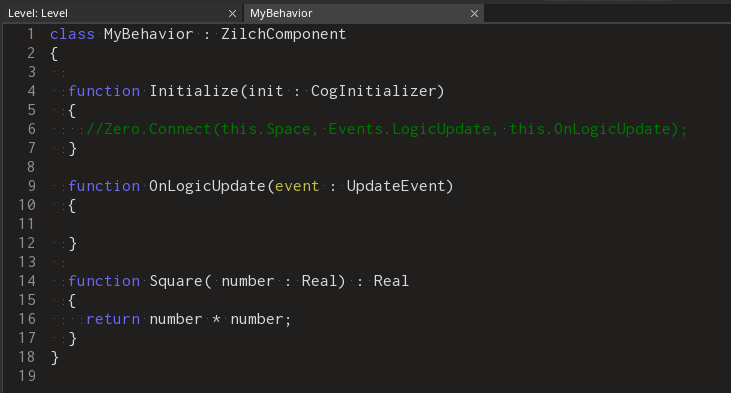This lesson covers the basics of using Functions in Nada.
Learning Objectives
- Defining & calling functions
- Function parameters and return types
- Calling functions from different components
Level Setup
- Command : New Project
- Create a new project using the {nav icon=clone, name=Empty 2D Project} template
- Command : CreateSprite
- Command : Add Resource
- Create a NadaScript resource using the Component template template and name it
MyBehavior - In the
Object Window - Select : Sprite object
- In the
Properties Window - Rename Sprite object to
Square - Add Component :
MyBehavior
Custom Functions
Functions are a sequence of logic statements that take a set of input variables with the goal of performing some operation. Functions are one of two main constructs within a class�the other being variables.
Declaration
Start declaring by typing function followed by a name and a pair parentheses:
function Square()
Parameters
An important feature of functions is their ability to take literals and variables as input, referred to as parameters. These parameters are passed into the function to supply the data needed to complete the intended operation. They are declared within the function's parentheses by giving each a parameter name, followed by a type (ParamName : ParamType).
function Square( number : Real )
NOTE: Functions can have any number of parameters (including none), each separated by a comma. These scenarios will be covered later.
Scope
Just like classes, functions have a defined scope within which all of its functionality is outlined. We denote the scope by adding a pair of curly braces.
function Square( number : Real )
{
}
Return Value
Some functions may provide a final result that can be returned back to the scope where it was invoked. These are called Return Types and are declared after the function's parentheses by typing colon : followed by the type to be returned.
function Square( number : Real ) : Real
{
}
NOTE: It is not necessary for a function to return anything, in such cases no return type needs to be specified.
Body
The body contains all the logic to be performed when the function is invoked. If the function has a Return Type, it is required to include a return statement within our function.
function Square( number : Real ) : Real
{
return number * number;
}
- Add the previous code block inside the
MyBehaviorclass.
Your code should look like this:

Invoking Functions
Now that we have created a function, it can be invoked elsewhere in code whenever the computations it provides are required.
When invoking a function that exists within the same class you can simply type:
this.Square(2.0);
Similar to accessing variables, when invoking an external function we must first reference the class to whom it belongs:
//Syntax used by an external code trying to invoke our function
this.Owner.MyBehavior.Square(2.0);
Inside the parentheses, we must then pass either a literal, a variable or an expression which evaluates to the required type of the parameter (as outlined by the function definition). If a function takes multiple parameters, they must each be passed to the function in order, separated by a comma.
Return Values
Once a function is invoked, all of the instructions outlined within its scope are invoked in sequence. Once a function reaches the end of its scope or a return statement, it will return control to the scope that invoked it along with the Return Value (if one was specified).
Example:
var pi : Real = 3.1415926;
var piSquare : Real = this.Square(pi);
//Print values to the console
Console.WriteLine("Pi: `pi`");
Console.WriteLine("Pi Square: `piSquare`");
WARNING: Functions may use conditionals; however, when a Return Type is declared, all code paths within the function must lead to a return statement. It is common to have multiple return statements that return different values depending on the branching logic within the function.
 Here, Nada gives us an error since we haven't specified a return value should the variable
Here, Nada gives us an error since we haven't specified a return value should the variable DoMath be false. A solution to this problem might be: 